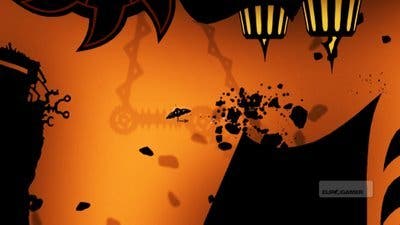Insanely Twisted Shadow Planet
Dark side of the Moon.
Insanely Twisted Shadow Planet is an unfamiliar pairing of familiar components.
The style is silhouette indie chic - a more colourful Limbo, a less intricate Pixel Junk Eden, a more serious World of Goo - each frame rendered in pin-sharp black vector ink that’s only just beginning to fade from fashion.
It’s a whisper world of foreground shadows and background soft focus shapes, of proto-life forms with feelers and pincers but no words. Craggy ceilings and underground lakes are the sights here. You may play as a flying saucer from the future, but everything around you has the feel of the primordial, an embryo domain of clicks and ominous keyboard swells.
Meanwhile, the structure is pure Super Metroid, depositing your diminutive spaceship into a 2D labyrinth. Your task is simple: chart the world by visiting every nook and cranny. Your progress in this aim is hampered by a series of convoluted locks, which require the correct key to be in your possession before they will let you though.
As such, in contrast to the try-hard zany name, Insanely Twisted Shadow Planet is essentially a game about tools and choosing the right one for the right job. There’s the circular saw, which you must use to cut your way through the brittle rock. And, once you’ve mastered this by applying it in a variety of situations, there’s the grappling claw that must be used to clear boulders and so on.
The drip feed of new tools continues across the game’s five hours. Puzzles scale with a mathematical elegance as the problems set before you require ever more elaborate combinations of tools before they’ll yield.

These are, of course, the foundation principles of all good game design: press a single tool into the player’s hands, and provide an opportunity for them to master it before presenting another. These principles rendered in the Metroidvania style have a clarity that is timelessly compelling, and Shadow Planet benefits greatly from the tried and tested formula.
Control of the ship is tight and satisfying. The game controls like a twin stick shooter, the left analogue stick controlling your movements, the right angling whichever of the nine bolt-on tools you have active at any given point. These are selected via a radial menu, with shortcuts to your favourite four manually mapped to the d-pad. Your ship has an unseen health meter, sprouting red fungus on its hull to show you how close it is to death, a sign that is washed away every time you pass through one of the regular checkpoint spheres that punctuate the world.
While its name implies oodles of charisma, in reality Shadow Planet suffers from a unwavering lack of character. The alien ship is a cold, near-silent avatar, and the world it seeks to penetrate is unforgiving and without warmth or solace. The decision to eradicate all text from the game adds to the style, but the lack of narrative and premise makes this an icy, clinical game that relies entirely upon the strength of its mechanics to provide motivation to its player.


